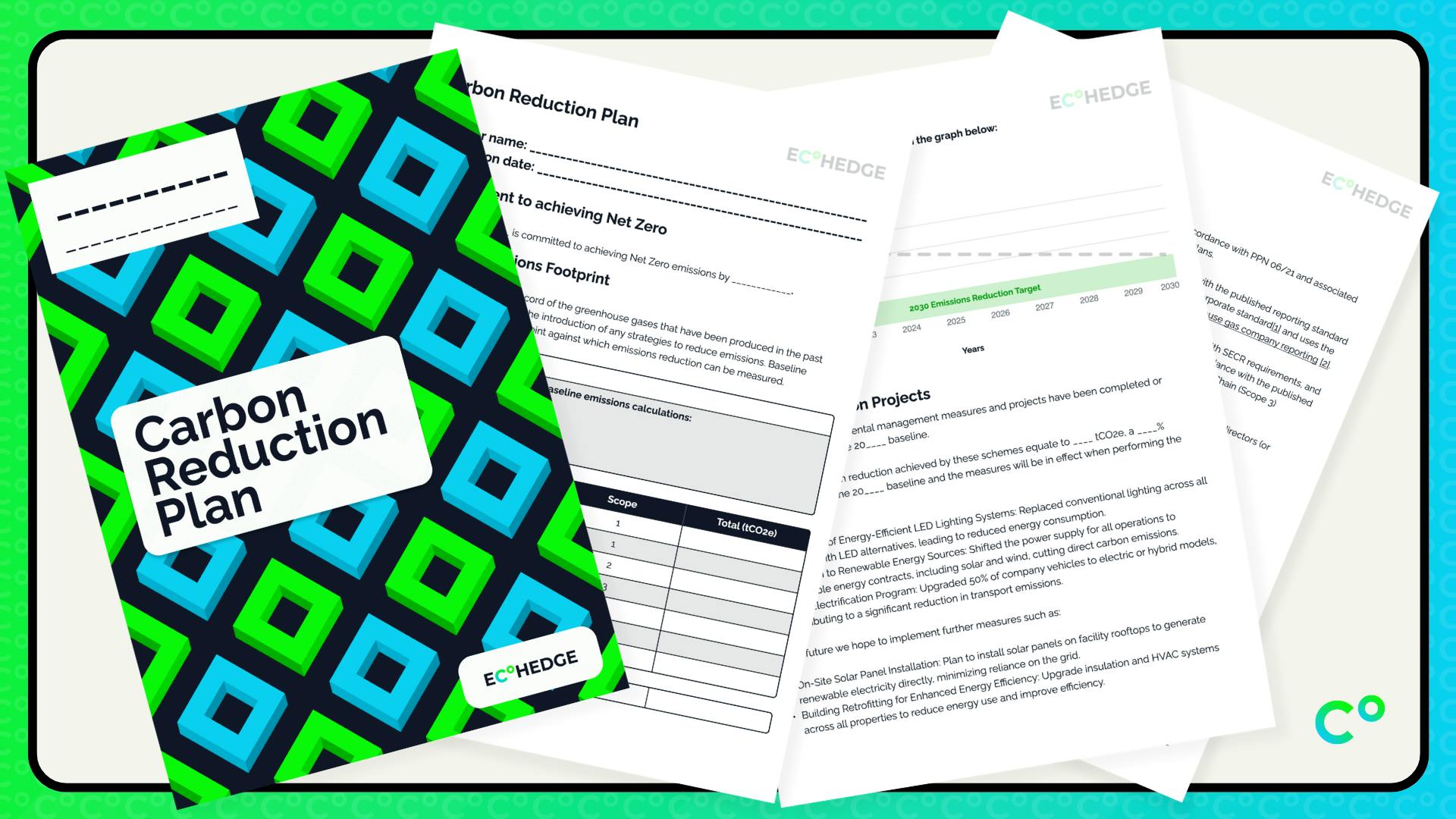With increasing attention on environmental sustainability, most business leaders would agree that understanding and reducing their company's environmental impact is important.
This article provides a step-by-step guide to mapping your business footprint - assessing the full environmental impact of your company's operations and supply chain.
You'll learn what a business footprint is, how to diagram yours, set emissions goals, transform your supply chain, innovate sustainable work environments, achieve credibility through certifications, and effectively market your company's green initiatives.
Decoding Business Footprint: An Introduction
Understanding your company's business footprint is key to mapping your environmental impact and improving sustainability.
What is a business footprint?
A business footprint refers to the total environmental impact of a company's operations, products, and services. It encompasses:
- Carbon footprint - Total greenhouse gas (GHG) emissions
- Water footprint - Total water usage
- Waste footprint - Total waste generated
- Biodiversity footprint - Impacts on ecosystems and wildlife
By measuring your business footprint, you gain visibility into areas causing the greatest harm so you can minimize ecological damage.
For example, identifying energy-intensive processes with a large carbon footprint allows you to implement clean energy solutions. Tackling water-intensive operations reduces your water footprint. Diverting waste from landfills shrinks your waste footprint.
Why is business footprint mapping important?
Understanding the size and components of your business footprint is the first step to curbing your environmental impact. Footprint measurement and reporting is key to:
- Complying with regulations - Governments worldwide are enacting sustainability disclosure laws. Mapping your footprint prepares your business for compliance.
- Satisfying stakeholders - Investors, customers, and employees demand ethical practices. Communicating your footprint and plans to shrink it demonstrates your commitment.
- Pursuing eco-efficiency - Spotting the largest footprint hotspots guides you toward the most impactful emission and resource reduction opportunities.
Taking these proactive sustainability steps today is vital for every business seeking to thrive in a net-zero future.
What does footprint mean in business?
A business footprint refers to the overall environmental impact of a company's operations, products, and services. It encompasses energy and resource consumption, greenhouse gas emissions, waste generation, biodiversity loss, and other ecological effects stemming from business activities.
Mapping out your business footprint involves measuring and analyzing these impacts across your entire value chain. This allows you to identify hotspots for improvement, set reduction targets, and track progress over time. It is an essential first step for any organization aiming to minimize ecological harm, enhance sustainability, and contribute towards vital ecological goals.
Understanding the components of your business footprint empowers you to make informed decisions that benefit both commercial growth and environmental wellbeing over the long term. An effective business footprint strategy calls for coordination across departments, robust data collection processes, and investment in technologies that drive efficiency. With the right approach, managing your footprint opens up opportunities to lower costs, inspire your workforce, attract conscientious investors and customers, and gain a competitive edge.
What is footprint concept?
The concept of a business footprint, often referred to as a "corporate footprint", refers to understanding and measuring the environmental impact of a company's operations. Just as an individual's carbon footprint quantifies their personal impact on the planet, a business footprint provides visibility into how business activities affect the environment.
Mapping out a business footprint involves calculating greenhouse gas emissions across the company's full value chain. This includes direct emissions from owned operations as well as indirect upstream and downstream emissions. A comprehensive corporate footprint provides visibility into climate risks and opportunities to reduce impact.
Key measurements in a business footprint analysis include:
- Carbon emissions (CO2e)
- Energy consumption
- Water usage
- Waste generation
- Supply chain emissions
By understanding its ecological impact, an organization can identify "hot spots" and create reduction strategies. For example, supply chain emissions often make up the majority of a company's footprint. Sourcing sustainable materials can significantly lower overall corporate emissions.
A strong sustainability program centered around minimizing its business footprint positions a company to meet stakeholder expectations around social responsibility while reducing operating costs and environmental risks. The path towards sustainability starts with awareness and measurement.
What is a commercial footprint?
A commercial footprint refers to the overall impact a business has on the environment and society. It encompasses the resources a company uses, the waste it generates, and its relationships with stakeholders.
Mapping out your business's commercial footprint involves taking a holistic view of its operations to understand its positive and negative effects. This can help identify opportunities to minimize harm, maximize benefit, and operate more sustainably.
Some key elements that comprise a commercial footprint include:
- Carbon emissions from energy use, transportation, supply chain, etc.
- Water usage for operations, products and services
- Waste production and recycling rates
- Impact on biodiversity and land use
- Local community relationships and social impact
- Ethical labor practices and supply chain oversight
- Product lifecycle effects from raw material sourcing through end-of-life
Understanding the multi-faceted nature of business footprints leads to more informed decisions and climate action plans. Software like EcoHedge provides data-driven insights to map footprints and track improvement over time.
What is a company's operational footprint?
A company's operational footprint encompasses all the locations and facilities that enable its business operations. This includes manufacturing plants, warehouses, distribution centers, retail stores, office spaces, data centers, and more.
The operational footprint drives a significant portion of a company's overall environmental impact and carbon emissions. Factors that contribute to the footprint include:
- Energy usage for lighting, HVAC systems, machinery, IT equipment across facilities
- Water consumption for manufacturing processes, cooling systems, restrooms, etc.
- Waste generation from industrial processes, food services, employee activities
- Transportation of goods via shipping fleets between locations
Mapping out these facilities and the resources they utilize is the first step to understanding, benchmarking, and reducing a company's overall business footprint. Tools like EcoHedge Lifecycle can help companies automate this mapping process and identify "hotspots" for improvement.
By taking a data-driven approach, companies can optimize their operational footprint over time - consolidating underutilized sites, switching to renewable energy, reducing waste, and more. The result is enhanced sustainability, lower costs, and positive public perception.
sbb-itb-919600f
Blueprints for Sustainability: Utilizing a Business Footprint Template
Understanding your company's environmental impact is the critical first step on the path towards sustainability. A business footprint template provides a structured way to assess your organization's ecological footprint across all business activities.
Using a standardized methodology like the Greenhouse Gas Protocol ensures consistent and accurate measurement. A business footprint analysis quantifies impacts across your full value chain, calculating direct and indirect emissions from operations, transportation, supply chain, product use, and more.
With clear visibility into carbon hotspots, you can then develop targeted reduction strategies. An effective business footprint template also tracks progression year-over-year, demonstrating concrete climate action to stakeholders.
Drafting the Business Footprint Diagram
Visually mapping out a business footprint uncovers sustainability insights and improves stakeholder communication. A business footprint diagram illustrates the size and scope of environmental impacts, answering questions like:
- What activities cause the most emissions?
- Which inputs and outputs drive our footprint?
- Where can we achieve the biggest reductions?
Footprint diagrams range from simple high-level overviews to detailed process flow mappings. Start by outlining key emissions sources within your organizational boundary. Then expand the analysis to include indirect impacts from purchased goods/services and product use.
A complete diagram traces the full lifecycle of key products, exposing eco-inefficiencies. It also captures offset initiatives, highlighting progress made. Well-designed diagrams use infographics to showcase sustainability credentials and performance clearly.
Examples of Business Footprint Success Stories
Leading brands have leveraged business footprint mapping to drive transformational efficiency gains:
- Retailer H&M open-sourced its supply chain sustainability data, enabling factories globally to benchmark performance. By scaling transparency, it accelerated industry-wide emissions reductions.
- Apple now runs its facilities on 100% renewable energy. Its Supplier Clean Energy program also helps component manufacturers transition to clean power - reducing upstream impacts.
- Microsoft has invested over $2 billion into carbon removal solutions. It applies an internal carbon tax to every group within the business to incentivize footprint reductions.
any company can follow in the footsteps of these corporate titans. An accurate understanding of your business footprint empowers impactful climate action.
Assessing and Minimizing Your Carbon Footprint
A step-by-step guide on evaluating and reducing the company's carbon emissions, with a focus on scopes 1, 2, and 3 of the Greenhouse Gas Protocol.
Establishing a Carbon Footprint Benchmark
Identifying initial emission levels and understanding the areas of highest environmental impact is the first step towards minimizing your business footprint. To establish a benchmark, conduct an emissions inventory to measure and record all relevant greenhouse gas emissions data across your operations. This includes:
- Scope 1 - Direct emissions from company owned and controlled sources like vehicles, facilities, and equipment.
- Scope 2 - Indirect emissions from purchased electricity used in owned or controlled equipment and operations.
- Scope 3 - All other indirect emissions from activities like procurement, logistics, business travel, waste disposal etc.
Once you map all emission sources and analyze historical usage data, you can calculate emissions using established conversion factors and standards. Tracking emissions over time allows you to pinpoint hotspots for reduction. For example, electricity usage and air travel may be disproportionately large contributors.
Setting a baseline creates a reference to judge future progress and build business footprint reduction plans. Companies serious about achieving net zero emissions often get their inventory and goals third-party verified for credibility.
Setting and Achieving Emissions Reduction Goals
With a benchmark established, set targeted objectives to minimize your company's climate impact year-over-year. Common reduction goal types include:
- Science-based - Aligning with latest climate science and your fair share of effort needed to limit global warming.
- Intensity-based - Lowering emission rates per unit of economic productivity over time.
- Absolute - Diminishing total emissions by a fixed annual percentage.
To meet goals, implement decarbonization initiatives across facilities, supply chain, employee commutes, air travel, and other emission intensive areas identified previously. Effective measures involve:
- Energy efficiency retrofits and renewable energy procurement for operations.
- Sustainable procurement standards for purchased goods and services.
- Offsetting unavoidable emissions through certified carbon removal projects.
- Engaging staff to adopt eco-conscious workplace behaviors.
Regularly tracking and reporting progress through annual sustainability reports builds trust and transparency with stakeholders about your business footprint minimization journey. Over time, you reap financial, societal, and environmental rewards from climate action leadership.
Actionable Strategies for a Greener Business Model
An exploration of various tactics businesses can implement to promote sustainability within their operations and supply chains.
Transforming the Supply Chain for Lower Environmental Footprints
Companies today are increasingly being held accountable for the business footprint of their entire supply chain. By taking steps to engage suppliers in sustainable practices, businesses can drive meaningful change and reduce their overall environmental impact.
Here are some effective strategies for greening your supply chain:
- Set sustainability guidelines - Develop a supplier code of conduct that sets clear expectations around waste reduction, renewable energy use, and responsible sourcing. Share these guidelines and make them part of supplier contracts.
- Map your supply chain - Conduct supply chain mapping to identify high-risk areas for environmental issues. This allows you to focus efforts on suppliers with the largest footprints.
- Educate and incentivize - Provide training and resources to help suppliers meet sustainability targets. Consider financial incentives or preferred status for eco-conscious suppliers.
- Leverage technology - Supply chain software can track carbon emissions, water usage, and waste data across all suppliers, enabling transparency and progress tracking.
- Seek certification - Require key suppliers to obtain recognized sustainability certifications like ISO 14001. This verifies their commitment.
By taking a collaborative approach, businesses can transform supply chains to be regenerative rather than extractive, creating shared value for all stakeholders. The long-term benefits for reputation, resiliency, and the environment make this a smart business footprint strategy.
Design Innovations for Sustainable Work Environments
The physical spaces where employees work each day also contribute to a company's carbon footprint. By incorporating sustainable design principles into offices, stores, and other work environments, businesses can operate in a more eco-friendly manner.
Here are some impactful ideas to consider:
- Energy efficiency - Install LED lighting, occupancy sensors, high-efficiency HVAC systems, and smart building controls to optimize energy use. Seek LEED or EnergyStar certification.
- Renewable energy - Source clean electricity through onsite solar panels or community renewable energy programs supported by utilities.
- Water conservation - Add low-flow plumbing fixtures. Collect rainwater for landscaping irrigation. Monitor usage with smart meters.
- Healthy materials - Use low-VOC paints and sustainable building materials like mass timber. Prioritize products with environmental certifications.
- Waste minimization - Provide centralized recycling stations. Ban single-use plastics. Set up composting programs.
- Alternative transportation - Encourage commuting by transit, bike, carpool, or EV shuttle. Provide electric vehicle charging stations.
A sustainability-focused workspace design helps organizations walk the walk when it comes to ecological stewardship. The employee engagement and talent attraction benefits can also make this a wise strategic business footprint decision.
Capitalizing on Sustainability: Growth through Green Initiatives
As businesses today contend with growing environmental concerns, many companies are realizing the value in showcasing credible sustainability efforts. Beyond safeguarding our planet, eco-conscious practices present tangible commercial benefits - from fortifying brand repute to capturing emerging green markets.
Let's explore key strategies to extract the most value from green initiatives.
Achieving Credibility with Sustainability Certifications
Gaining recognized sustainability certifications signals that your business meets reputable environmental standards - affirming the authenticity of efforts for stakeholders.
Renowned sustainability reporting frameworks like the Global Reporting Initiative (GRI) and global disclosure platform CDP (formerly Carbon Disclosure Project) enable businesses to consistently report performance. Adhering to such standards confers credibility and trust in your company's environmental practices.
You can also pursue respected eco-labels like B Corp or Climate Neutral certifications. These verify adherence to strict sustainability requirements - identifying your company as responsible and value-driven.
The right credentials make sustainability claims credible - establishing your business as ethically-minded amidst rampant greenwashing. This builds stakeholder and consumer confidence, driving preference for your brand.
Eco-branding: Marketing Your Green Journey
With certifications affirming your credibility, compelling communications convey commitment, inviting customer and investor buy-in.
An environmental sustainability report details your concrete actions towards ecological aims - quantifying progress to showcase accountability. Embed visual data representations and highlight key metrics like greenhouse gas emission figures. This elucidates the scale of impact - energizing stakeholders.
Share company eco-exploits on your website, social media and press releases as well. For example, an energy conservation campaign's outcomes or a product's net reductions in business footprint. Use infographics to vividly capture milestones - bringing stories to life.
Transparent, inspiring communications stir excitement around the sustainability vision you spearhead. This cements strong emotional ties between purpose-driven consumers and your brand - forging lasting relationships that buoy sales.
Capitalizing on green progress cultivates immense commercial gains - if strategically leveraged through certifications and communications for credibility and emotive stakeholder buy-in. Let your sustainability efforts shine brightly; the returns can be well worth the investment.
Charting a Greener Course: The Road Ahead
As businesses seek to reduce their environmental impact and contribute to global sustainability efforts, strategically mapping their business footprint becomes imperative.
By understanding the full scope of business operations, resource usage, supply chains, and stakeholder impacts, companies can pinpoint areas for improvement. Assessing business footprint allows for informed target-setting and data-driven strategies to minimize ecological harm.
With the right carbon accounting tools and methodologies, mapping out emissions data and sustainability metrics need not be complex or resource-intensive. Automated software solutions like EcoHedge simplifies the process into a few easy steps:
- Connect data sources
- Customize assessments
- Access interactive dashboards
Armed with accurate business footprint mapping, companies can confidently chart a course towards comprehensive decarbonization, optimized efficiency, and ethical stakeholder engagement. The path ahead leads to resiliency, future-readiness and leadership.



